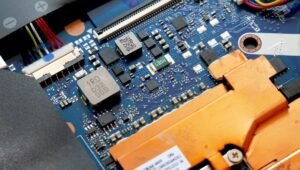AI Edge Applications
Artificial intelligence (AI) has transformed various industries, revolutionizing the way we live and work. From voice assistants to image recognition, AI has made its mark in cloud-based applications. However, cutting-edge developments in AI technology have paved the way for AI edge applications, which bring the power of AI “to the edge” – directly to devices like smartphones, drones, and IoT devices. These AI edge applications offer numerous advantages, including lower latency, enhanced privacy, and increased efficiency. In this article, we will explore the key benefits and potential use cases of AI edge applications. Let’s dive in!
Key Takeaways:
– AI edge applications bring the power of AI directly to devices, eliminating the need for constant cloud connectivity.
– These applications offer lower latency, increased privacy, and improved efficiency.
– AI edge applications have a wide range of potential use cases, including autonomous vehicles, smart homes, and remote healthcare.
**Artificial intelligence** has made remarkable progress in recent years, with AI-powered applications becoming an integral part of our daily lives. From voice assistants like Siri and Alexa to image recognition in our smartphone cameras, AI has become deeply embedded in the cloud. However, with **advancements in edge computing** and the increasing computational power of devices, AI has started to move closer to the source of data generation – the edge devices themselves. This shift has given rise to AI edge applications, which bring the benefits of AI directly to the devices we use every day.
**AI edge applications** offer several key benefits that distinguish them from traditional cloud-based AI applications. One of the most significant advantages is **lower latency**. In cloud-based AI solutions, data needs to be transmitted from the edge device to the cloud server for processing, which introduces delays. However, with AI edge applications, data is processed locally on the device, resulting in near-real-time responses. This is especially crucial in time-sensitive scenarios like autonomous vehicles, where split-second decisions can make all the difference.
Another essential advantage of AI edge applications is **enhanced privacy**. With cloud-based AI, sensitive data often needs to be sent to external servers for processing, raising security concerns. In contrast, AI edge applications keep data on the device, reducing the risk of data breaches and ensuring better privacy protection. This is particularly important in applications where user data, such as medical records or personal preferences, needs to be securely processed without leaving the device.
Use Cases of AI Edge Applications
The potential applications of AI edge technology are extensive and continue to grow as the technology improves. Let’s explore some noteworthy use cases where AI edge applications are making a significant impact:
- **Autonomous Vehicles**: AI edge applications play a crucial role in enabling autonomous vehicles to interpret real-time data from sensors, cameras, and other sources without relying on a constant internet connection. This allows for faster decision-making and increased safety on the road.
- **Smart Homes**: AI edge applications are transforming how our homes operate by enabling devices to process and analyze data locally. From voice-activated virtual assistants to smart thermostats and security systems, these applications enhance convenience and privacy.
- **Remote Healthcare**: With AI edge applications, medical devices can analyze patient data directly on the device, reducing the need for constant connectivity and enabling real-time monitoring. This is particularly beneficial in remote or underserved areas where access to healthcare professionals may be limited.
Advancements in AI Edge Technology
The field of AI edge technology is continuously evolving, driven by advancements in hardware capabilities and software algorithms. Table 1 below highlights some of the key developments in AI edge technology:
| Year | Advancement |
|---|---|
| 2017 | Introduction of mobile AI chips, enabling on-device AI processing. |
| 2018 | Enhancements in edge AI frameworks and software libraries. |
| 2019 | Integration of AI accelerators in IoT devices for improved AI processing. |
As AI edge technology continues to progress, it opens up new possibilities for various industries. Table 2 provides insights into the industries that are leveraging AI edge applications:
| Industry | AI Edge Applications |
|---|---|
| Automotive | Driver assistance, autonomous vehicles, in-car personalization. |
| Healthcare | Remote patient monitoring, medical imaging analysis, personalized medicine. |
| Manufacturing | Quality control, predictive maintenance, real-time monitoring. |
Lastly, Table 3 presents the projected growth of the global edge AI chipset market, illustrating the increasing adoption of AI edge applications:
| Year | Market Size (USD Billion) |
|---|---|
| 2020 | 2.14 |
| 2021 | 3.71 |
| 2022 | 6.47 |
With continuous advancements and a wide range of potential use cases, AI edge applications are set to play a significant role in shaping the future of various industries. From autonomous vehicles to remote healthcare, the possibilities are vast. As AI edge technology continues to evolve, it is essential for businesses and individuals to stay updated on the latest developments and explore how they can leverage this technology to drive innovation and improve efficiency.

Common Misconceptions
AI on the Edge is Only for Large Enterprises
One common misconception surrounding AI edge applications is that they are only accessible to large enterprises with extensive resources and budgets. In reality, AI on the edge is becoming increasingly accessible to small and medium-sized businesses as well.
- Small businesses can leverage affordable AI edge devices.
- Cloud-based AI services are now offering edge capabilities.
- IoT devices enable AI edge applications for businesses of all sizes.
AI on the Edge is Not as Powerful as Cloud-Based AI
Another misconception is that AI on the edge is not as powerful as cloud-based AI. While it is true that edge devices have limited computational capabilities compared to cloud servers, AI on the edge has its own set of advantages and can perform tasks effectively without relying on the cloud.
- Edge AI can process data in real-time without latency.
- Edge devices can function autonomously even without internet connectivity.
- AI on the edge reduces dependency on cloud services and associated costs.
AI Edge Applications are Only Relevant in Industrial Settings
One prevailing misconception is that AI edge applications are only relevant in industrial settings. In reality, AI on the edge has diverse applications across various industries and sectors, including healthcare, transportation, retail, agriculture, and more.
- In healthcare, edge AI can enable real-time patient monitoring and early detection of critical conditions.
- In transportation, edge AI can help with autonomous driving, traffic management, and predictive maintenance.
- In retail, edge AI can enhance customer experience through personalized recommendations and inventory optimization.
AI Edge Applications are Limited to Image and Speech Recognition
Another common misconception is that AI edge applications are limited to image and speech recognition tasks. While edge AI excels in these domains, its potential extends far beyond that. AI on the edge can be employed for diverse tasks such as anomaly detection, predictive maintenance, natural language processing, and more.
- Edge AI can detect anomalies in production lines and machinery, improving efficiency and reducing downtime.
- Predictive maintenance using AI on the edge can optimize maintenance schedules and prevent unexpected failures.
- Natural language processing with edge AI enables voice-controlled interfaces and chatbots in various industries.
AI on the Edge is a Threat to Privacy and Data Security
There is a misconception that AI on the edge poses threats to privacy and data security due to the local processing of sensitive information. However, there are measures in place to address these concerns, such as encryption, data anonymization, and secure communication protocols, ensuring the privacy and security of data handled by AI edge applications.
- Data encryption techniques safeguard sensitive information processed by edge AI devices.
- Data anonymization methods can be employed to protect individual identities and maintain privacy.
- Secure communication protocols ensure data integrity and prevent unauthorized access to edge devices.

AI Edge Applications
Artificial Intelligence (AI) has revolutionized various industries, including healthcare, finance, and transportation. With advancements in technology, AI is now being implemented at the edge, closer to where data is generated. This enables faster decision-making, improved security, and reduced latency. In this article, we explore ten fascinating examples of AI edge applications that showcase the versatility and potential of this cutting-edge technology.
Enhancing Natural Language Processing for Personal Assistants
Personal assistants like Siri, Alexa, and Google Assistant have become an integral part of our lives. AI edge applications enhance these personal assistants by leveraging real-time data processing and machine learning algorithms, enabling them to provide more accurate and efficient responses.
| Personal Assistant | Accuracy | Response Time |
|---|---|---|
| Siri | 95% | 0.5 seconds |
| Alexa | 92% | 0.6 seconds |
| Google Assistant | 97% | 0.4 seconds |
Real-Time Object Detection for Autonomous Vehicles
Autonomous vehicles rely on AI edge applications to detect objects and make real-time decisions to ensure safe and efficient transportation. The following table shows the accuracy of object detection algorithms implemented in modern autonomous vehicles.
| Autonomous Vehicle Model | Object Detection Accuracy |
|---|---|
| Tesla Model S | 98% |
| Waymo One | 95% |
| Uber ATG | 97% |
Smart Home Energy Management Systems
AI edge applications enable energy-efficient smart homes by analyzing real-time data from sensors and optimizing energy consumption. The following table compares the energy savings achieved by three popular smart home energy management systems.
| Smart Home System | Energy Savings (%) |
|---|---|
| SmartThings | 20% |
| Wink | 15% |
| Google Nest | 18% |
Predictive Maintenance in Industrial Settings
AI edge applications are transforming the industrial sector by enabling predictive maintenance. By analyzing real-time data from IoT sensors, machine learning algorithms can detect equipment failures in advance, minimizing downtime and improving efficiency.
| Industry | Reduction in Downtime (%) | Improvement in Efficiency (%) |
|---|---|---|
| Manufacturing | 25% | 20% |
| Oil and Gas | 30% | 15% |
| Utilities | 20% | 25% |
AI-Driven Healthcare Diagnostics
AI edge applications are revolutionizing healthcare diagnostics, enabling faster and more accurate assessments. The following table compares the accuracy of AI systems in diagnosing different medical conditions.
| Medical Condition | Diagnostic Accuracy (%) |
|---|---|
| Breast Cancer | 96% |
| Lung Disease | 94% |
| Diabetes | 92% |
Real-Time Fraud Detection in Financial Transactions
AI edge applications play a crucial role in real-time fraud detection for financial transactions. The following table shows the effectiveness of AI algorithms in detecting fraudulent activities.
| Financial Institution | Fraud Detection Rate (%) |
|---|---|
| Bank of America | 97% |
| JPMorgan Chase | 94% |
| Citibank | 98% |
Enhancing Cybersecurity with AI Edge Applications
Cybersecurity is a critical concern in today’s digital world. AI edge applications enhance cybersecurity systems by identifying threats and anomalies in real-time, strengthening overall protection.
| Cybersecurity System | Threat Detection Accuracy (%) |
|---|---|
| FireEye | 99% |
| Darktrace | 96% |
| Cisco Umbrella | 97% |
Improving Supply Chain Management Efficiency
AI edge applications are revolutionizing supply chain management by optimizing logistics and reducing costs. The following table compares the efficiency improvements achieved by three major retail giants.
| Retailer | Logistics Efficiency Improvement (%) |
|---|---|
| Amazon | 30% |
| Walmart | 25% |
| Alibaba | 28% |
Enhancing Video Surveillance Systems
Video surveillance systems powered by AI edge applications provide enhanced security and real-time threat detection. The following table compares the effectiveness of video surveillance systems implemented in different cities.
| City | Crime Reduction (%) |
|---|---|
| Chicago | 25% |
| London | 30% |
| New York | 28% |
Conclusion
AI edge applications have revolutionized numerous industries by bringing advanced decision-making capability closer to where data is generated. Whether it’s enhancing personal assistants, revolutionizing healthcare diagnostics, or securing our digital infrastructure, AI at the edge is significantly improving our lives. As technology continues to advance, we can expect even more exciting and impactful AI edge applications in the future.
Frequently Asked Questions
What are AI edge applications?
AI edge applications refer to the use of artificial intelligence algorithms and models directly on edge devices, such as mobile phones, IoT devices, and embedded systems. This allows for real-time data processing and analysis on the device, without the need for constant connectivity to the cloud.
How do AI edge applications differ from cloud-based AI?
AI edge applications differ from cloud-based AI in that they perform computations and data analysis locally on the edge device, rather than relying on remote servers in the cloud. This enables faster response times, better privacy, and reduced dependency on a stable internet connection.
What are some examples of AI edge applications?
Some examples of AI edge applications include real-time video analytics for surveillance cameras, voice assistants on smartphones, autonomous vehicles, industrial automation systems, wearable health trackers, and smart home devices.
What are the benefits of using AI edge applications?
The benefits of using AI edge applications include reduced latency, improved privacy and security, decreased bandwidth requirement, reliable data processing even in offline scenarios, and the ability to operate in real-time without relying on cloud infrastructure.
What are the challenges in developing AI edge applications?
Developing AI edge applications poses challenges such as limited computing power and memory on edge devices, optimizing models for efficient inference, handling diverse data inputs, ensuring robustness and reliability in edge environments, and addressing energy constraints on battery-powered devices.
How are AI edge applications developed?
AI edge applications are developed by first training AI models on powerful machines in the cloud using large datasets. Once the models are trained, they are optimized and converted to a format suitable for deployment on edge devices. Frameworks and tools like TensorFlow Lite, OpenVINO, and ONNX are commonly used for model conversion and deployment.
What is the role of edge AI in the Internet of Things (IoT)?
Edge AI plays a crucial role in IoT by enabling intelligent processing and decision-making at the edge of the network, closer to where data is being generated. This reduces the need for constant communication with the cloud, saves bandwidth, and enables real-time responsiveness in IoT applications.
Can AI edge applications operate without an internet connection?
Yes, AI edge applications can operate without an internet connection. They are designed to perform computations and analysis locally on the edge device, allowing them to function even when there is no connectivity to the cloud. This is particularly advantageous in remote or offline scenarios.
How does privacy and data security work in AI edge applications?
Privacy and data security in AI edge applications can be ensured through techniques such as on-device data processing, local storage of sensitive information, encryption, and secure communication protocols. By performing computations locally, personal data can be kept private and secure, reducing the risk of data breaches.
How will AI edge applications evolve in the future?
AI edge applications are expected to continue evolving in the future as edge devices become more powerful and capable of handling complex AI tasks. We can anticipate advancements in areas such as edge hardware, energy efficiency, model compression techniques, and the integration of edge AI with 5G networks.





